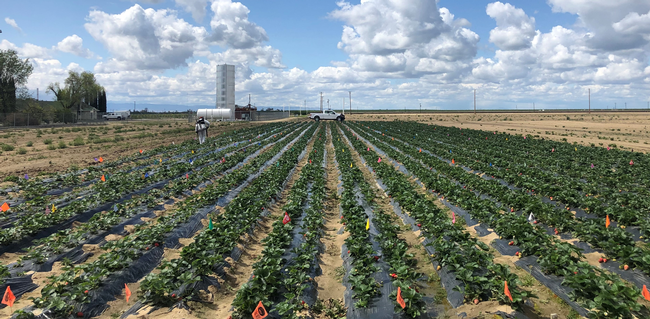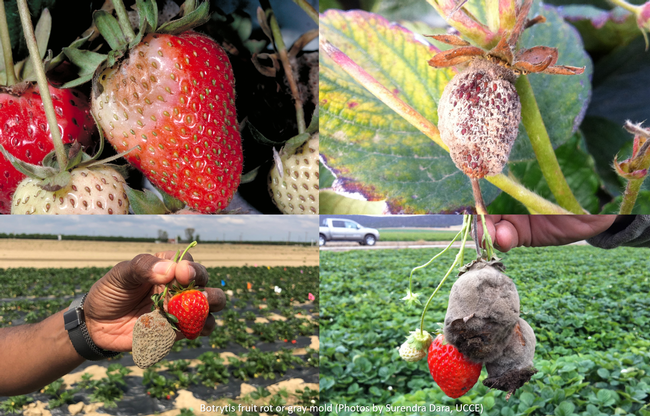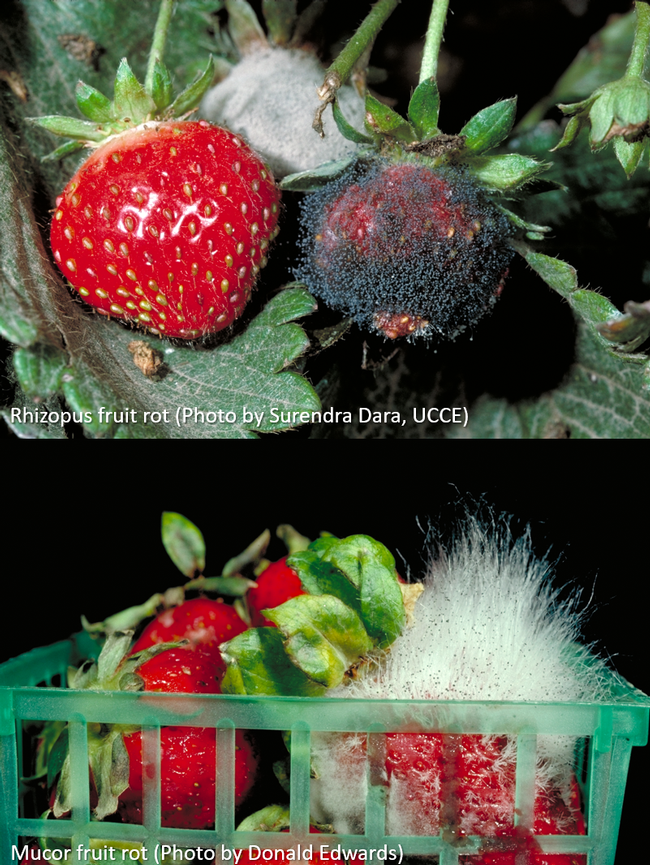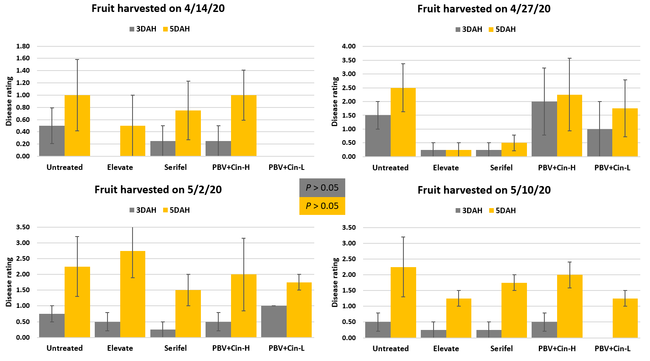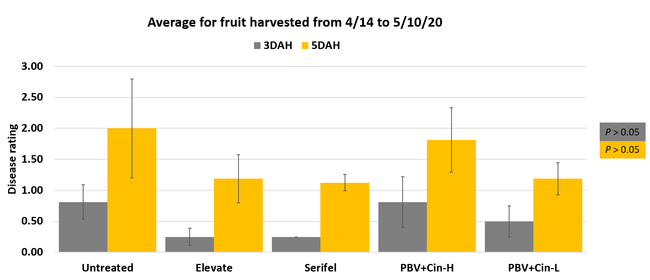Several crown, fruit, and foliar diseases cause significant yield losses to strawberry. Gray mold or Botrytis fruit rot caused by Botrytis cinerea, mucor fruit rot by Mucor spp., and Rhizopus fruit rot by Rhizopus spp. are common fungal diseases in California. Botrytis cinerea is more prevalent and damaging fungus among these pathogens warranting regular fungicidal applications. Fungal spores survive in plant debris and soil and infection can occur before flower initiation. Both flowers and fruits are subjected to infection. Severely infected flowers fail to develop into fruits. Infection on developing or ripe fruit occurs as brown lesions, usually under calyxes. Infected areas rot and become dry and leathery under dry conditions or produce a thick, gray mat of spores under cool, moist conditions.
Mucor spp. invade the fruit through ruptured skin and cause leaky fruit rot. Under high humidity, profuse fungal growth of white, tough filaments with black spore-bearing structures is seen covering the fruit. In the case of Rhizopus fruit rot, discolored, water-soaked spots develop on fruit eventually leading to wilting. Similar to the Mucor fruit rot, Rhizopus rot also leads to leaky fruits and development of black spore-bearing structures on white mycelia under high humidity. Both pathogens survive in dead and decaying plant material and can persist in the field.
In a fall-planted conventional strawberry, growers usually make 12 or more fungicidal applications during a four-month period to control Botrytis and other fruit rots. Although fungicides with different modes of action are present and growers try to rotate them, fungicide resistance in B. cinerea is common and effective integrated disease strategies are necessary. Using biostimulants that might improve plant's ability to withstand diseases and alternating chemicals with biological fungicides could be some options to mitigate chemical fungicide resistance. Previous studies looked at the response of fruit diseases to various treatments that received biological soil amendments (Dara, 2020a), soil fungicides (Dara, 2020b), or chemical and biological fungicides (Dara, 2019). This study was conducted to evaluate the efficacy of some biological fungicides along with a chemical fungicide primarily against Botrytis fruit rot.
Methodology
This study was conducted at a research strawberry field at the Shafter Research Station. Strawberry cultivar San Andreas was planted on 31 October 2019. Other than regular irrigation and fertigation, plants in this study were not treated with any agricultural inputs for agronomic or pest management purposes. Treatments included i) untreated control, ii) Elevate 50 WDG (fenhexamid) at 8 oz/ac, iii) Serifel (Bacillus amyloliquefaciens) at 8 oz/ac, iv) ProBlad Verde (Banda de Lupinus albus doce – BLAD, a polypeptide from sweet lupine) at 36 fl oz with Cinnerate (cinnamon oil) at 0.25% followed by ProBlad Verde at 36, 43, and 43 fl oz/ac on subsequent applications, and v) ProBlad Verde at 36 fl oz with Cinnerate at 0.25% followed by three subsequent applications of ProBlad Verde at 32 fl oz/ac. Each treatment had a 3.2' wide and 14' long plot with two rows of plants and replicated four times in a randomized complete block design. Treatments were applied using a CO2-pressurized backpack sprayer using a 45 gpa spray volume on 26 March, 2, 10, and 20 April 2020. Flowers and fruits were removed from all the plants before the first application. Fruit was harvested on 14 and 27 April and 2 and 10 May and stored in vented plastic containers for postharvest quality assessment. The severity of Botrytis and other fruit rots was recorded 3 and 5 days after harvest on a scale of 0 to 4 where 0=no disease, 1=1-25% fruit with fungal infection, 2=26-50% infection, 3=51-75%, and 4=76-100%. Compared to Botrytis fruit rot, other rots occurred as mixed infections at different times and it was not possible to accurately measure them separately. Data presented in this study primarily represent Botrytis fruit rot with other fruit rots included on some data sets. Data were subjected to analysis of variance using Statistix software to compare disease severity for individual harvest dates and their average.
Results
Fruit rots occurred from low to moderate levels during the observation period. Disease severity followed the usual trend with higher levels 5 days after harvest compared to 3 days after harvest. Compared to untreated control, disease severity was numerically lower in some treatments especially 3 days after harvest, but differences were not statistically significant (P > 0.05) when individual harvest dates or their average were considered. The average disease severity from four harvests was 0.25 in Elevate and Serifel, 0.50 in ProBlad Verde low rate with Cinnerate, and 0.81 in ProBlad Verde high rate with Cinnerate treatment and untreated control 3 days after harvest. The average disease severity was 1.13 for Serifel, 1.19 for Elevate and the low rate of ProBlad Verde with Cinnerate, 1.81 for the high rate of ProBlad Verde with Cinnerate, and 2.0 for untreated control 5 days after harvest. Although statistically significant differences could not be found among treatments, this study indicates the potential of non-chemical alternatives and warrants additional studies for further investigation.
Acknowledgements: Thanks to BASF and Sym-Agro for funding this study and Marjan Heidarian Dehkordi and Zach Woolpert for the technical assistance.
References
Dara, S. K. 2019. Five shades of gray mold control in strawberry: evaluating chemical, organic oil, botanical, bacterial, and fungal active ingredients. UCANR eJournal of Entomology and Biologicals. https://ucanr.edu/blogs/blogcore/postdetail.cfm?postnum=30729
Dara, S. K. 2020a. Improving strawberry yields with biostimulants and nutrient supplements: a 2019-2020 study. UCANR eJournal of Entomology and Biologicals. https://ucanr.edu/blogs/blogcore/postdetail.cfm?postnum=43631
Dara, S. K. 2020b. Impact of drip application of fungicides on strawberry health and yields. UCANR eJournal of Entomology and Biologicals. https://ucanr.edu/blogs/blogcore/postdetail.cfm?postnum=43632
